Contents
| |||||
| Decades: | |||||
|---|---|---|---|---|---|
| See also: | Other events of 1569 History of France • Timeline • Years | ||||
Events from the year 1569 in France .
| |||||
| Decades: | |||||
|---|---|---|---|---|---|
| See also: | Other events of 1569 History of France • Timeline • Years | ||||
Events from the year 1569 in France .
The 1640s decade ran from January 1, 1640, to December 31, 1649.

1814 (MDCCCXIV) was a common year starting on Saturday of the Gregorian calendar and a common year starting on Thursday of the Julian calendar, the 1814th year of the Common Era (CE) and Anno Domini (AD) designations, the 814th year of the 2nd millennium, the 14th year of the 19th century, and the 5th year of the 1810s decade. As of the start of 1814, the Gregorian calendar was 12 days ahead of the Julian calendar, which remained in localized use until 1923.

1813 (MDCCCXIII) was a common year starting on Friday of the Gregorian calendar and a common year starting on Wednesday of the Julian calendar, the 1813th year of the Common Era (CE) and Anno Domini (AD) designations, the 813th year of the 2nd millennium, the 13th year of the 19th century, and the 4th year of the 1810s decade. As of the start of 1813, the Gregorian calendar was 12 days ahead of the Julian calendar, which remained in localized use until 1923.

1650 (MDCL) was a common year starting on Saturday of the Gregorian calendar and a common year starting on Tuesday of the Julian calendar, the 1650th year of the Common Era (CE) and Anno Domini (AD) designations, the 650th year of the 2nd millennium, the 50th year of the 17th century, and the 1st year of the 1650s decade. As of the start of 1650, the Gregorian calendar was 10 days ahead of the Julian calendar, which remained in localized use until 1923.

1646 (MDCXLVI) was a common year starting on Monday of the Gregorian calendar and a common year starting on Thursday of the Julian calendar, the 1646th year of the Common Era (CE) and Anno Domini (AD) designations, the 646th year of the 2nd millennium, the 46th year of the 17th century, and the 7th year of the 1640s decade. As of the start of 1646, the Gregorian calendar was 10 days ahead of the Julian calendar, which remained in localized use until 1923.

1643 (MDCXLIII) was a common year starting on Thursday of the Gregorian calendar and a common year starting on Sunday of the Julian calendar, the 1643rd year of the Common Era (CE) and Anno Domini (AD) designations, the 643rd year of the 2nd millennium, the 43rd year of the 17th century, and the 4th year of the 1640s decade. As of the start of 1643, the Gregorian calendar was 10 days ahead of the Julian calendar, which remained in localized use until 1923.

1793 (MDCCXCIII) was a common year starting on Tuesday of the Gregorian calendar and a common year starting on Saturday of the Julian calendar, the 1793rd year of the Common Era (CE) and Anno Domini (AD) designations, the 793rd year of the 2nd millennium, the 93rd year of the 18th century, and the 4th year of the 1790s decade. As of the start of 1793, the Gregorian calendar was 11 days ahead of the Julian calendar, which remained in localized use until 1923.

1759 (MDCCLIX) was a common year starting on Monday of the Gregorian calendar and a common year starting on Friday of the Julian calendar, the 1759th year of the Common Era (CE) and Anno Domini (AD) designations, the 759th year of the 2nd millennium, the 59th year of the 18th century, and the 10th and last year of the 1750s decade. As of the start of 1759, the Gregorian calendar was 11 days ahead of the Julian calendar, which remained in localized use until 1923.
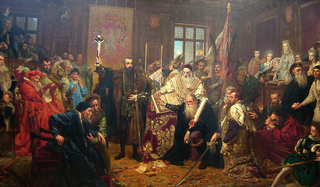
Year 1569 (MDLXIX) was a common year starting on Saturday of the Julian calendar.
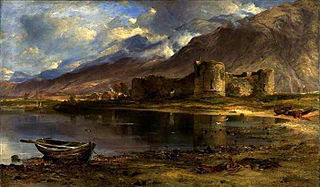
1645 (MDCXLV) was a common year starting on Sunday of the Gregorian calendar and a common year starting on Wednesday of the Julian calendar, the 1645th year of the Common Era (CE) and Anno Domini (AD) designations, the 645th year of the 2nd millennium, the 45th year of the 17th century, and the 6th year of the 1640s decade. As of the start of 1645, the Gregorian calendar was 10 days ahead of the Julian calendar, which remained in localized use until 1923.

1659 (MDCLIX) was a common year starting on Wednesday of the Gregorian calendar and a common year starting on Saturday of the Julian calendar, the 1659th year of the Common Era (CE) and Anno Domini (AD) designations, the 659th year of the 2nd millennium, the 59th year of the 17th century, and the 10th and last year of the 1650s decade. As of the start of 1659, the Gregorian calendar was 10 days ahead of the Julian calendar, which remained in localized use until 1923.
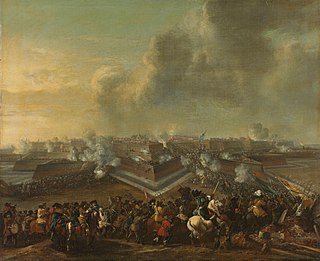
1672 (MDCLXXII) was a leap year starting on Friday of the Gregorian calendar and a leap year starting on Monday of the Julian calendar, the 1672nd year of the Common Era (CE) and Anno Domini (AD) designations, the 672nd year of the 2nd millennium, the 72nd year of the 17th century, and the 3rd year of the 1670s decade. As of the start of 1672, the Gregorian calendar was 10 days ahead of the Julian calendar, which remained in localized use until 1923.
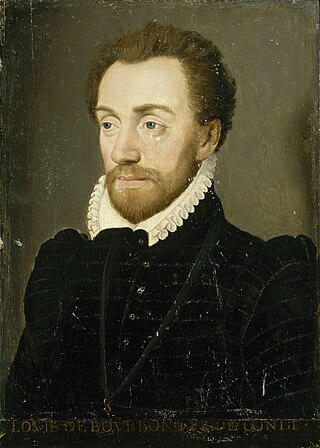
Louis de Bourbon, 1st Prince of Condé was a prominent Huguenot leader and general, the founder of the Condé branch of the House of Bourbon. Coming from a position of relative political unimportance during the reign of Henri II, Condé's support for the Huguenots, along with his leading role in the conspiracy of Amboise and its aftermath, pushed him to the centre of French politics. Arrested during the reign of Francis II then released upon the latter's premature death, he would lead the Huguenot forces in the first three civil wars of the French Wars of Religion before being executed after his defeat at the Battle of Jarnac in 1569.
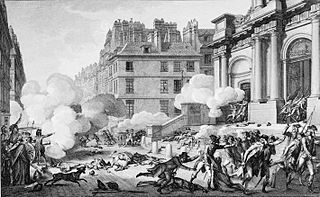
13 Vendémiaire, Year 4 in the French Republican Calendar, is the name given to a battle between the French Revolutionary troops and Royalist forces in the streets of Paris. This battle was part of the establishing of a new form of government, the Directory, and it was a major factor in the rapid advancement of Republican General Napoleon Bonaparte's career.

The Battle of Moncontour occurred on 3 October 1569 between the royalist Catholic forces of King Charles IX of France, commanded by Henry, Duke of Anjou, and the Huguenots commanded by Gaspard de Coligny.
The Battle of La Roche-l'Abeille occurred on 25 June 1569 between the Catholic forces of King Charles IX of France commanded by the Duke d’Anjou and the Huguenots commanded by the Admiral de Coligny during the "Third War" (1568–1570) of the French Wars of Religion.

Aimargues is a commune in the Gard department in southern France. The town of Aimargues may have Roman origins and is situated beside the river Vidourle on the floodplain of the Rhône. Traditionally it has been an agricultural and wine-producing community but it now also has a number of new industries and employers who benefit from excellent road connections to the north of France as well as to Spain and Italy.
Events from the year 1572 in France.
Events from the year 1567 in France.

The siege of Poitiers was a siege of the French city of Poitiers in summer 1569 as part of the French Wars of Religion. By that time the city was a Catholic stronghold faithful to Charles IX of France, though Jean Calvin had preached there in 1534 and it had taken the Protestant side from May to July 1563 before being recaptured by the Catholic Royalist party.